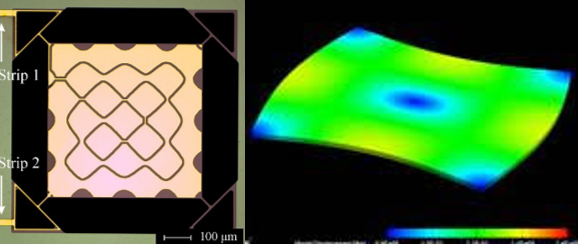MSc thesis project proposal
Piezoelectric resonators with high quality factor for frequency references
Time references based on oscillator circuits are present in almost any consumer electronic device. Mechanical resonators are an essential building block of modern oscillators. In the last years, MEMS resonators have substituted quartz TSM resonators, due to their small size, high temperature stability and immunity to mechanical shock [1]. Electrostatically driven resonators, featuring high quality factors but small electromechanical coupling are the dominant resonator type in today’s market. Nevertheless, piezoelectric resonators have the potential to achieve superior performance, given their superior electromechanical coupling, and can be monolithically integrated with CMOS circuits. The main remaining obstacle is their limited quality factors. This project will explore novel resonator designs exploiting symmetric vibration modes to reduce anchor losses and boost the quality factor.
Assignment
- Perform a literature review on existing MEMS resonators for time-keeping applications and their main performance metrics for oscillator circuits.
- Design, simulate and optimize piezoelectric mechanical resonators based on aluminum nitride.
- Fabricate the designed devices, using and optimizing fabrication methods already available at EKL.
- Characterize the resulting devices with electrical and optical measurements.
Requirements
You must be motivated to learn and apply different techniques for fabricating new devices. Notions of mechanical resonators or acoustic devices is desirable. Experience with FEM simulation packages such as Comsol is a plus.
[1] Van Beek, J. T. M., & Puers, R. (2011). A review of MEMS oscillators for frequency reference and timing applications. Journal of Micromechanics and Microengineering, 22(1), 013001.
[2] Chen, C. Y., Li, M. H., & Li, S. S. (2018). CMOS-MEMS resonators and oscillators: A review. Sensors Mater., 30(4), 733-756.
Contact
dr. Tomás Manzaneque
Electronic Instrumentation Group
Department of Microelectronics
Last modified: 2024-02-05
